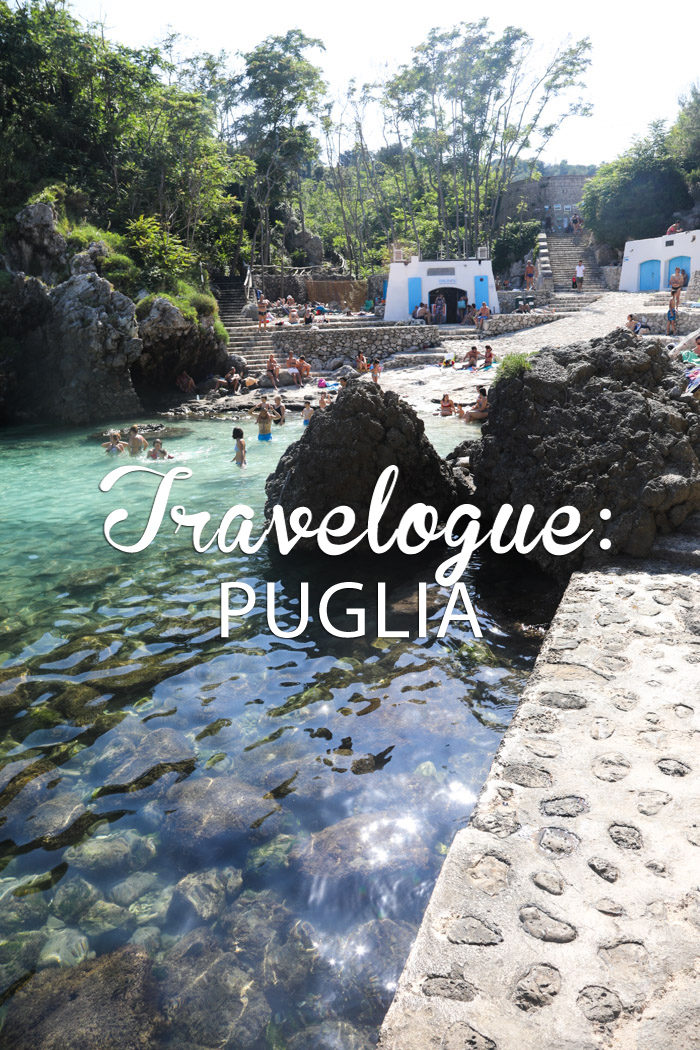
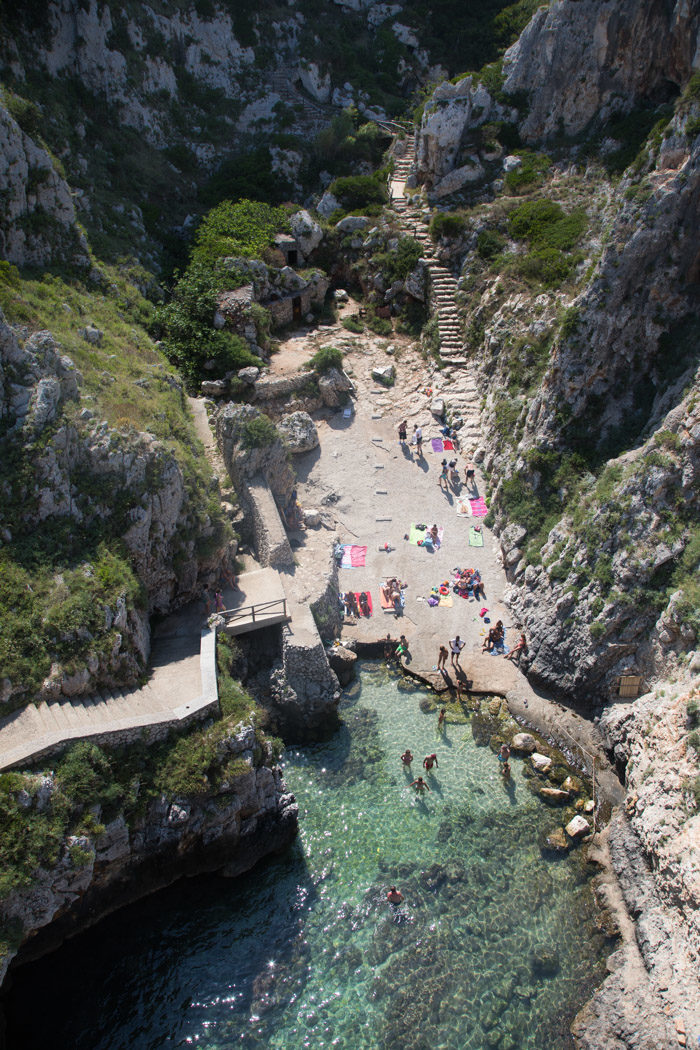
From Lecce, we drove south, deeper into the stiletto heel of Puglia, to where the Valle d’Itria ends and the peninsula, with the Adriatic sea to the the east, the Ionian to the west, begins: the Salento.
Surrounded by azure waters, beautiful beaches, and dramatic rocky coastline on both sides, the Salento is a paradise for sea lovers. We clung to the east, to the Adriatic coastline, which tends to offer the greatest variety of karstic grottoes, chalk cliffs, sandy shores, and salt-water lagoons.
And though our home base would be inland, just outside of a small village called Spongano, we couldn’t wait to spend our first day at one of its many marvelous stretches.
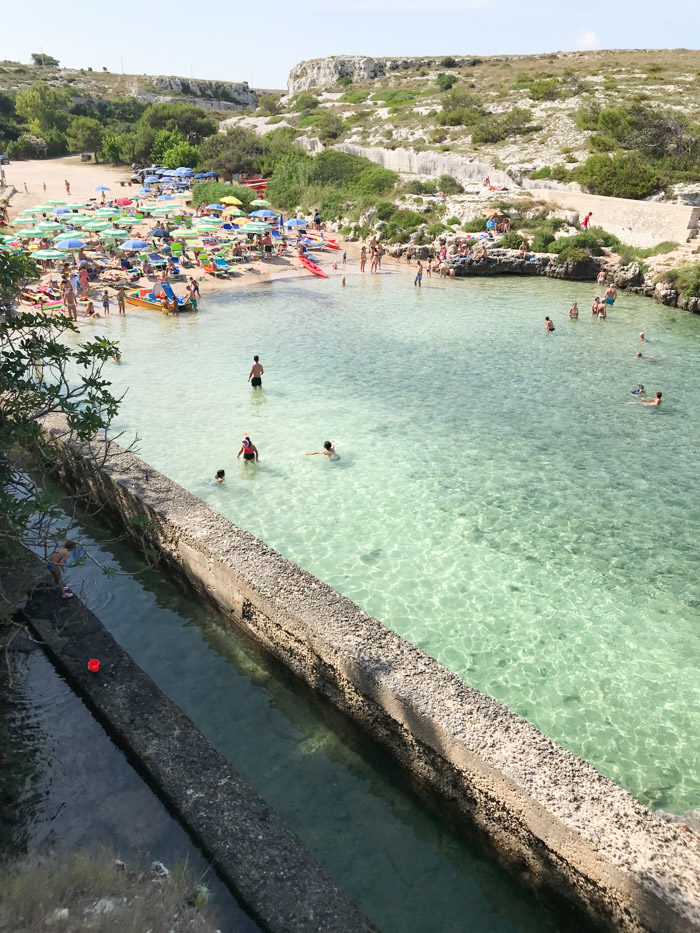
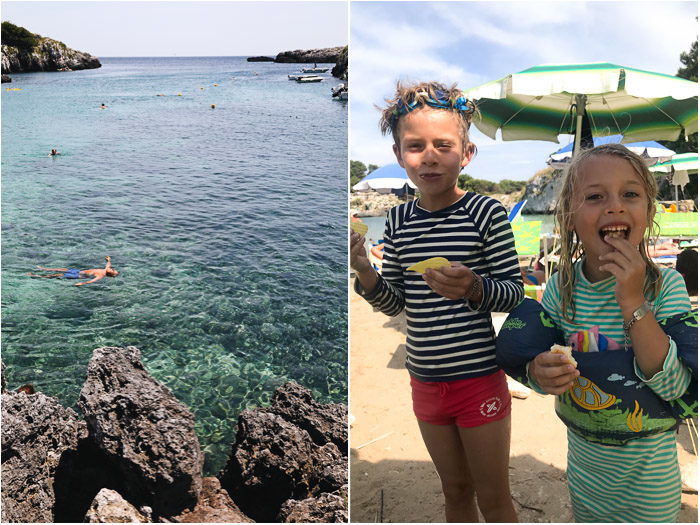
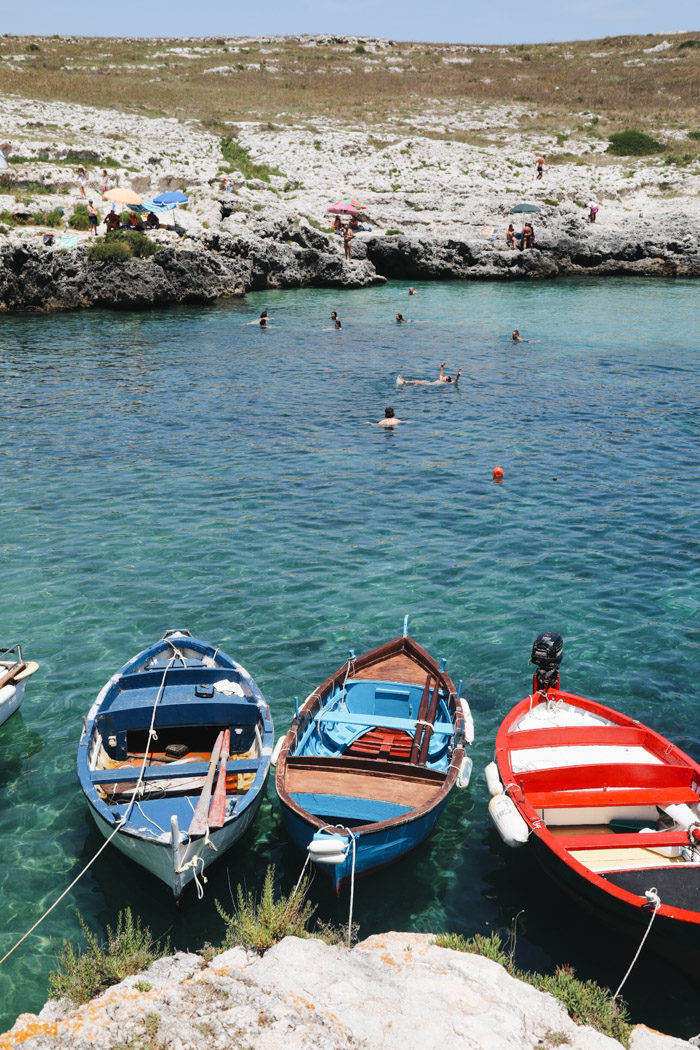
We chose to first stop at Porto Badisco, a rocky inlet with a slip of sandy beach for our day in the sun. Legend has it that Porto Badisco was where Aeneas first set foot on Italian soil upon arrival from Carthage.
I’d read that it’s famous for its wealth of urchins—ricci di mare are the pride of the area. In the summer, people eat the urchins by the hundreds, buying them at the local market just south of the cove or diving for them. Unfortunately, we were too early for the season which officially begins in July. It is illegal to procure them during the months of May and June.
No matter, it was the perfect stop for us: we parked in the carpark at the top of the road (you can pay an attendant a little extra for shade), picked up some fruit from a roadside stand, and walked down to the beach to rent a couple of loungers and umbrellas. The cove is deep-set within two rocky granite ridges that protect it from the wind—the sheltered waters were wonderful for kids—and we all felt a little thrill upon seeing it for the first time.



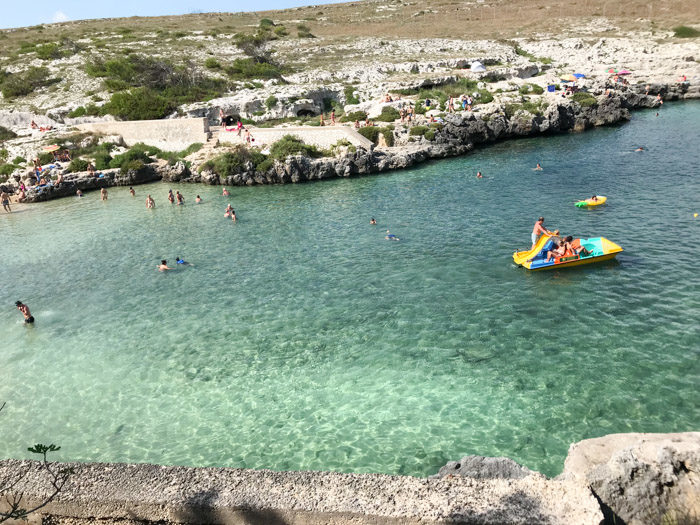
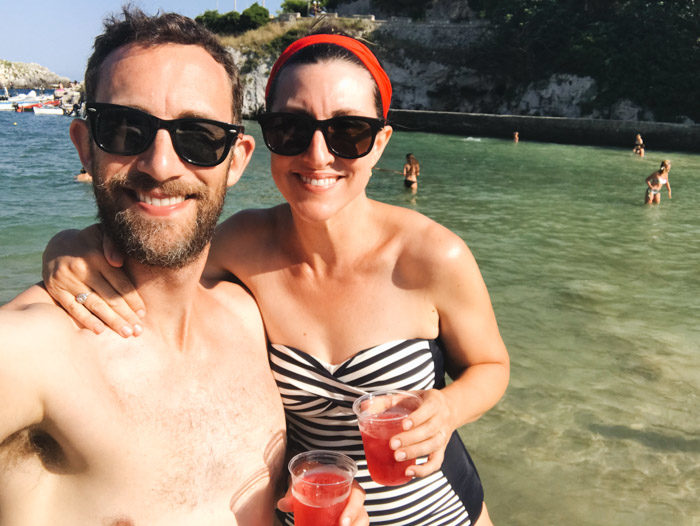
Outfitters in the cove rent kayaks and paddleboats, and there was a stand selling bathingsuits and anything else you might need for a day at the beach. We all bought swim shoes, and I picked up a headband and a straw purse. I also noticed a dive boat heading out with the group Dive Fraula, if you’re certified! The children had a blast playing in the sand and making new friends. Crabbing, like soccer, appeared to be a universal language when it comes to finding playmates.
For no-frills lunch or drinks, there’s Ristorante L’Approdo di Enea—practically on the sand—or the Bar Alimentari da Carlo at the top of the road. I’d suggest stopping at the latter and putting together a picnic. (Apparently this is also where, in season, a fisherman sets up shop and sells sea urchins, opening them on the spot.)
Though we chose to spend all of our time in or near the water, the Grotta dei Cervi (Cave of the Deer)—home to cave paintings which date back 4000 years—is nearby.
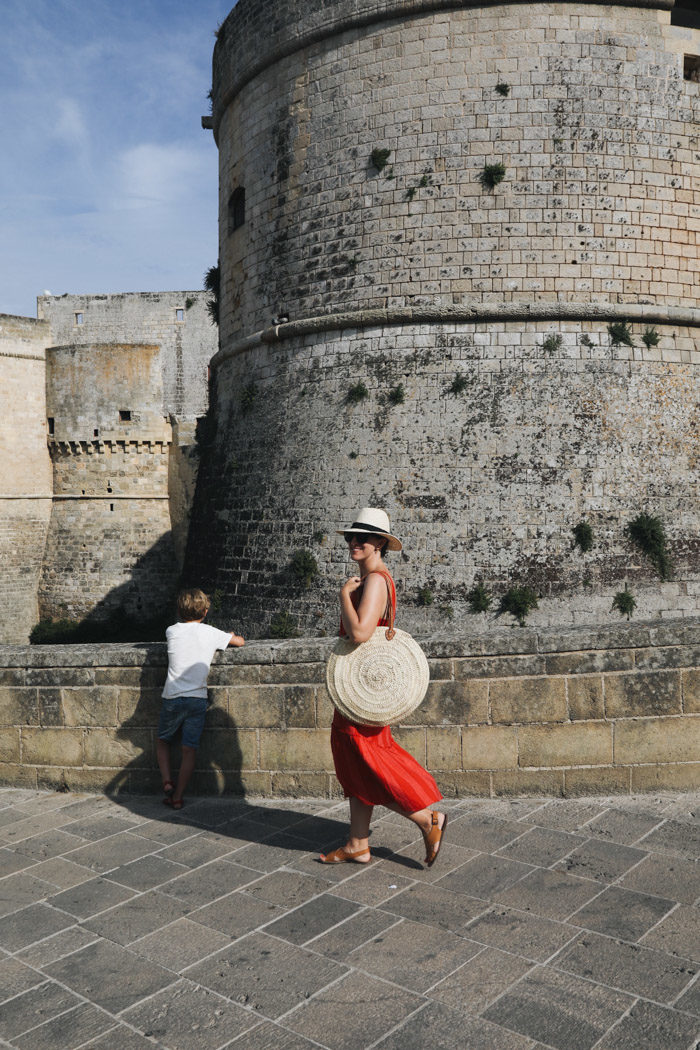
Just up the coast, we made a short stop in the fortified town of Otranto (famous for its elaborate mosaics and display of martyrs’ remains in its 12th-century cathedral), before going on to find our Airbnb. We returned a second time, later in the week, so I’ll save Otranto for the next travelogue and consolidate our visit.
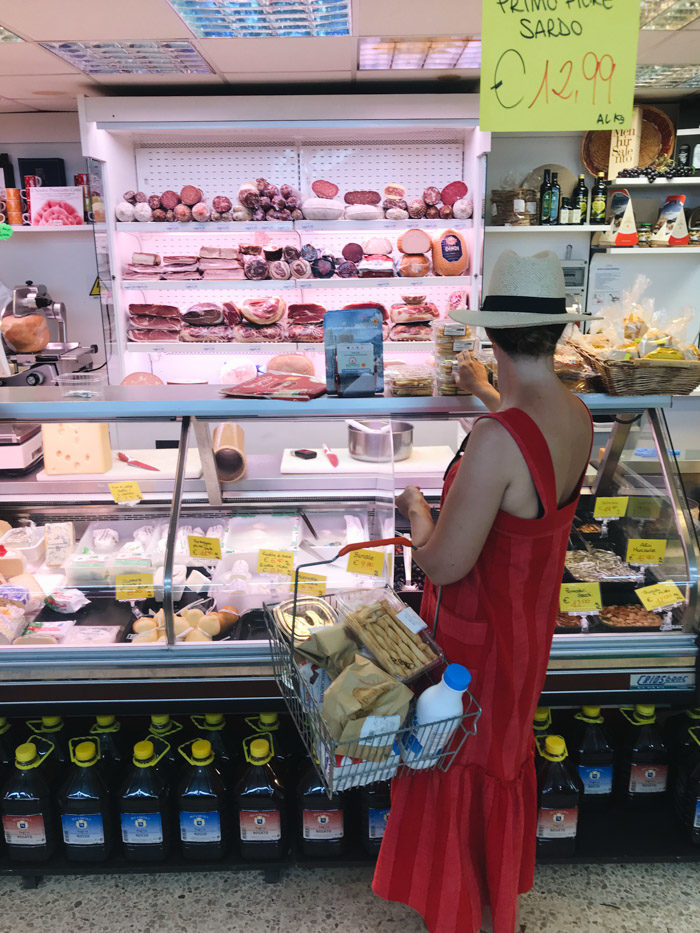

Stopping in Otranto also gave us an opportunity to stock up on groceries: knowing that we would have a kitchen for the next few days meant plenty of cheese and salumi.
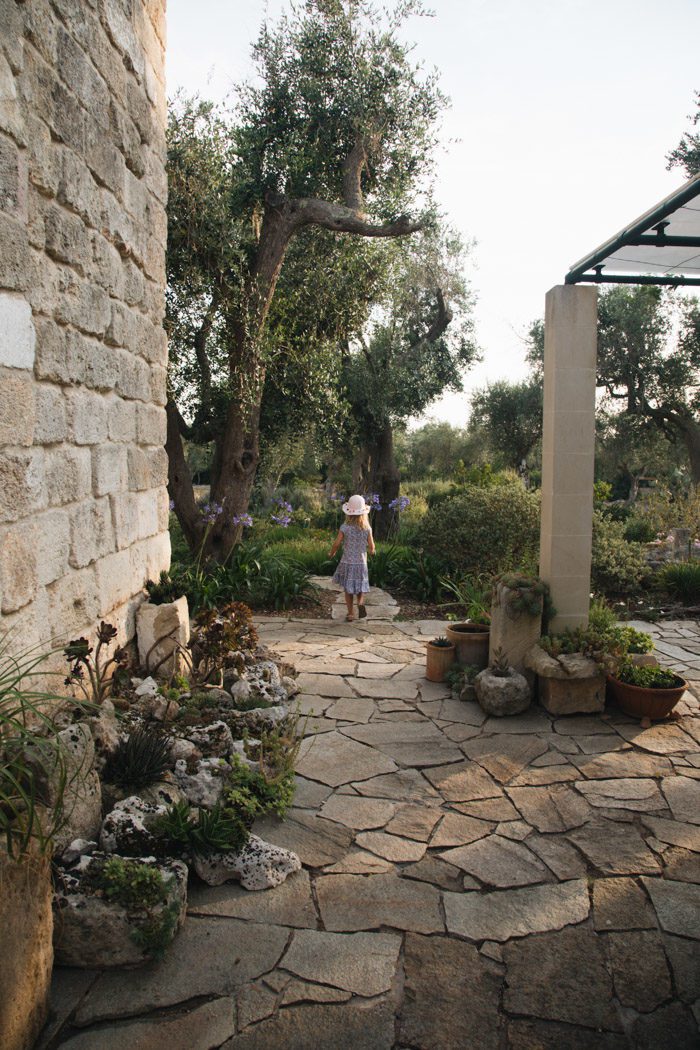

We pulled up to Our Airbnb to meet the host just before sunset and it blew us away! Located just outside of the small village of Spongano, and set among olive groves, the owners had built a stone home inspired by the paiara—local dry-stone shelters built for farmers—opening up an entire side with glass windows that looked out into the garden and onto the trees. They called it Il Grillo, the cricket, but it was the hum of cicadas which greeted us.
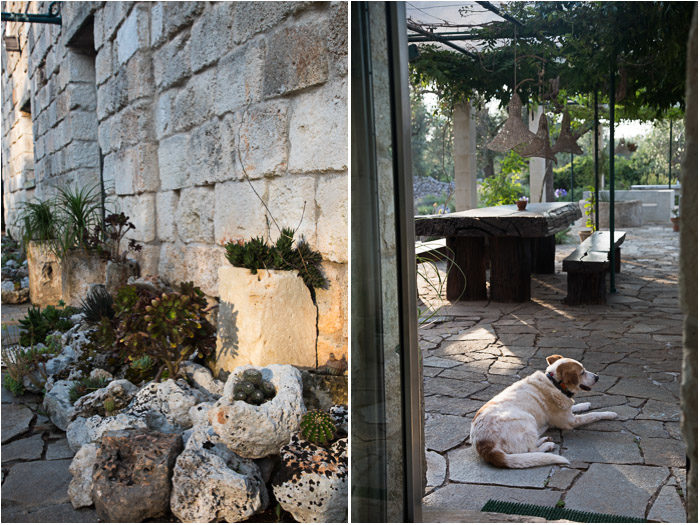

Also there to greet us: Frizzle, a stray dog who had moved in years ago and claimed the property as her own. We enjoyed having a pet for this part of our stay. There was also a cat, another dog (too shy to say hello), and some lizards and geckos.
We couldn’t believe our good fortune to find such a beautiful place to call home for a few days (and did splurge a bit accordingly). Every detail was lovely—from the rock-hewn planters to the giant wood-slab dining table set under grapevines.
The home was filled with beautiful treasures from around the world, yet felt very minimal so as not to distract from the gorgeous surroundings. One of my favorite touches was that when you’d step into the hallway at night, a light would turn on under an olive tree in the distance and your perspective would seem to reach much further. Everything seemed to bring the inside and outside together.
One of the owners, I later realized, is a photographer I’m familiar with from his book, Where Children Sleep—I had featured it in a blog post on Baby Mine years ago!
They’d put together a list of recommendations for the surrounding area. I was inspired to learn that it is only 1-1/2-hour walk from the village of Castro, on the Adriatic, even if that wouldn’t be on our itinerary this time.
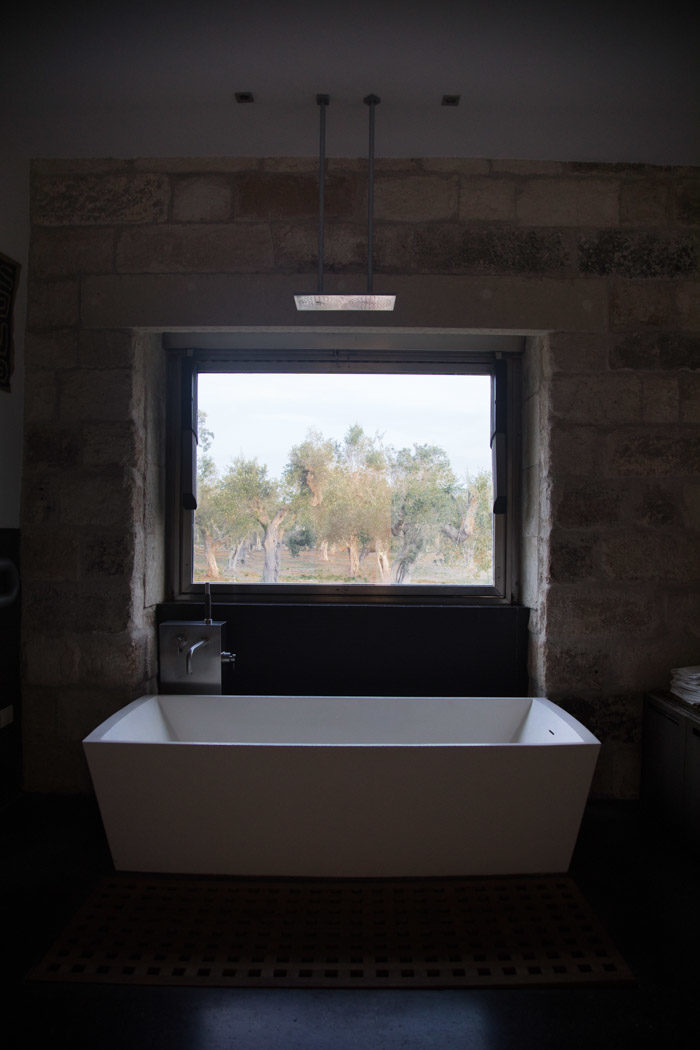
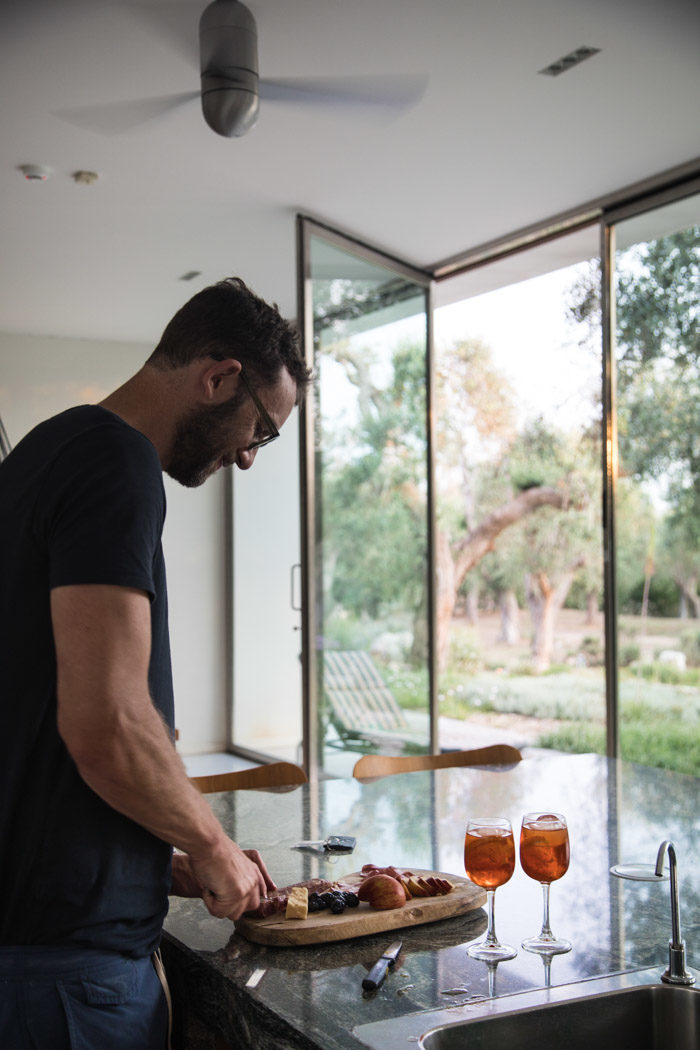
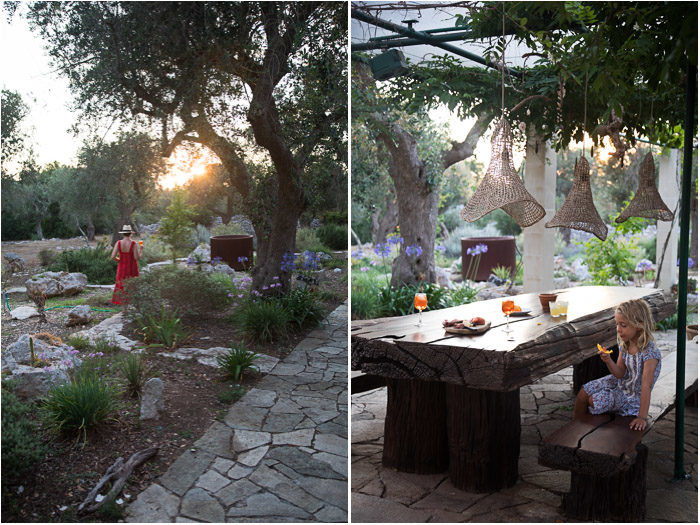
We made ourselves some cocktails and snacks and explored our new home, happy to know we wouldn’t have to set off in search of dinner.
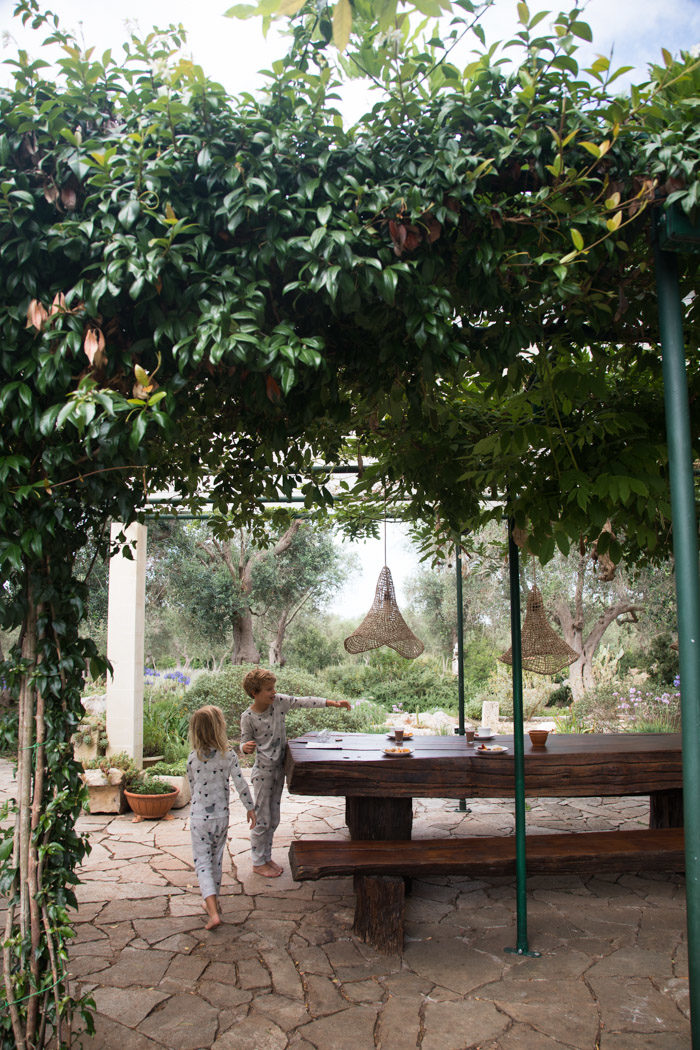
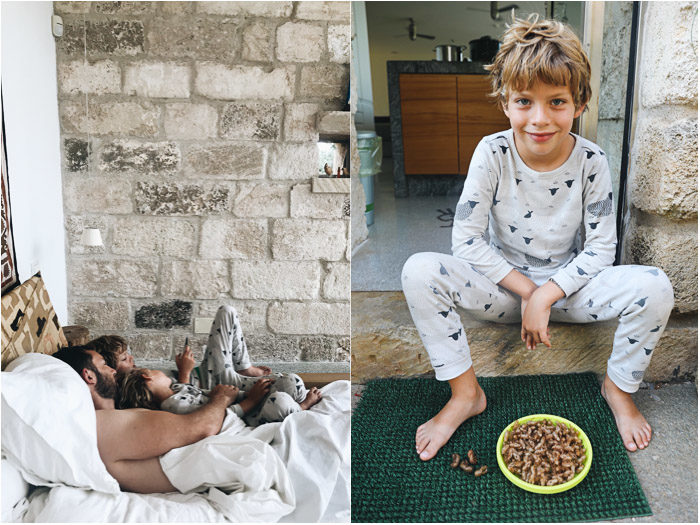
Everyone was fine with some lazier mornings—and a refrigerator stocked with favorite breakfast items. The kids never did come to appreciate pastries as breakfast, and looked forward to coming home to bananas and peanut butter and scrambled eggs after our trip.
The two of them would set off in search of bugs (that’s Hudson with a collection of Cicada casings) and lizards and—while I wouldn’t say we’d been roughing it or anything—life on this part of the trip felt very easy.
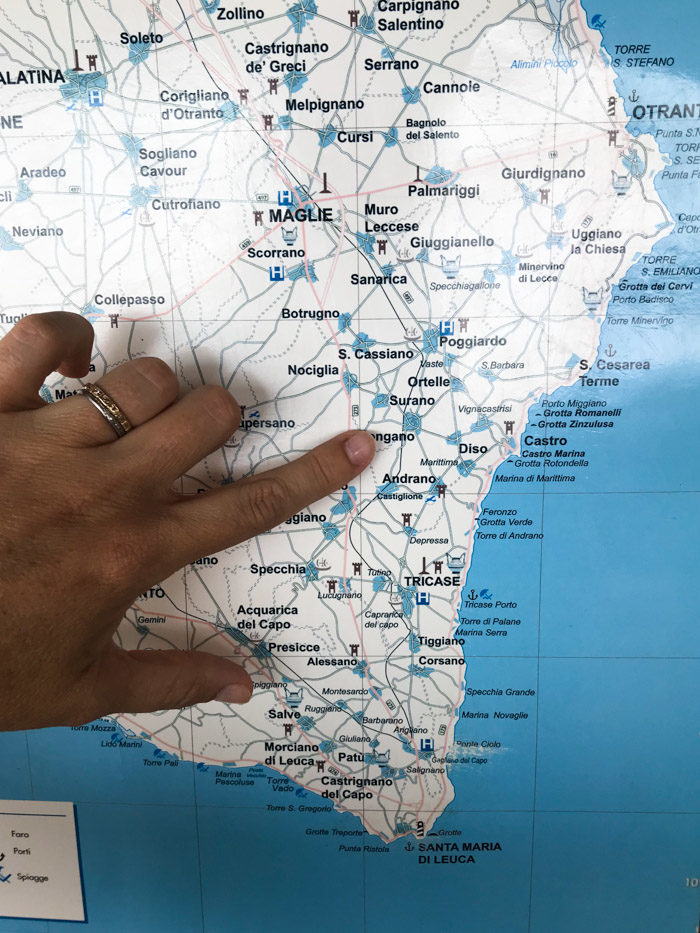


When we did get back in the car, we set out for the sea. Our first stop, Marina Serra, just south of Tricase Porto, has a sea-water swimming pool cut from the rock. We stopped for a while to swim—but found ourselves wanting for a more open shore, and drove on to Castro. If you ever find yourself at Marina Serra, I’d suggest heading to the south end (right, as you face the water) and looking to the small inlets just outside of the pool. The water’s clarity and color was incredible, and the crowd thinned a bit.


The Castro Marina turned out to be one of our favorite stops: we had a simple fried-shrimp and fried-fish lunch (the kids went crazy for little fish, the “fries with eyes,” as my friend calls them) by the port—with prosecco!—and then walked down to rent a paddle boat for an hour. You can also find boat tours and boat rental kiosks in the little marina.
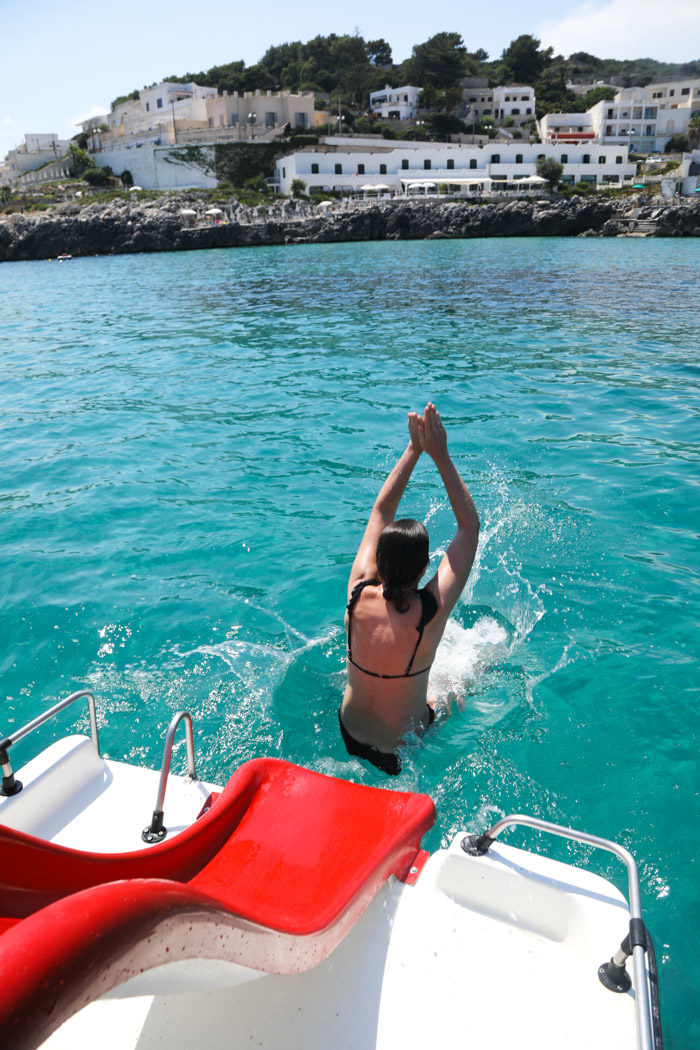
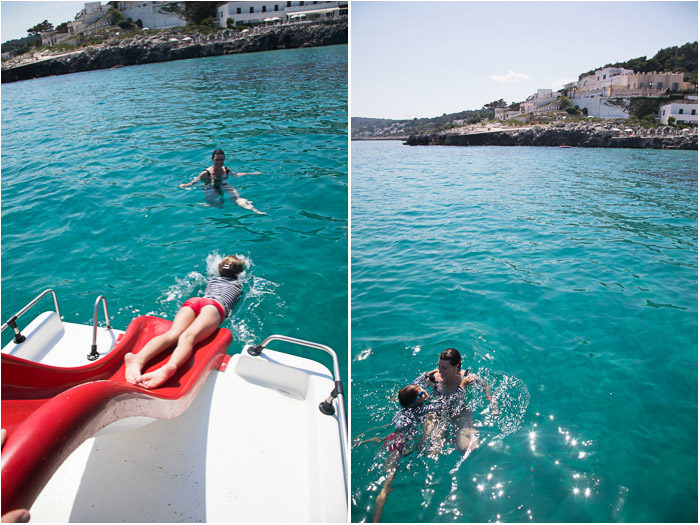
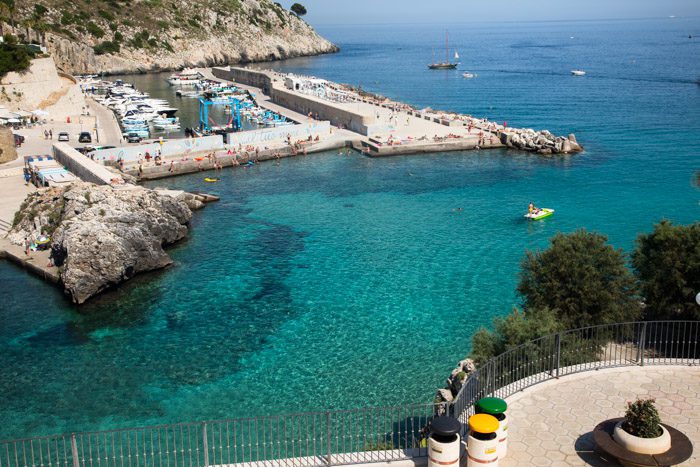
The Castro Marina has been awarded a Blue Flag for the last few years—as has much of this coastline—for its clean waters, and it was a gorgeous place to paddle out and dive and slide into the cool water! (Over and over again.) When you look back at the shore, you not only see the beach clubs and the marina, but up above stands the defensive citadel of old Castro with its evocative castle.
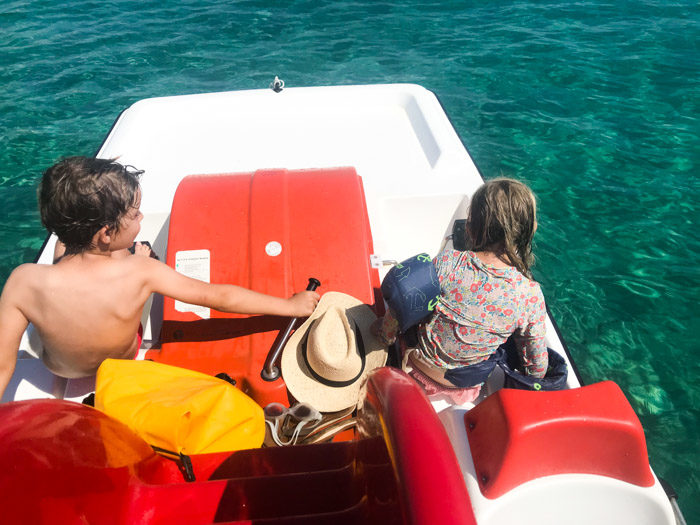
When we asked Hudson and Skyler later about their favorite parts of the trip, driving the paddle boat and jumping off definitely made the list.
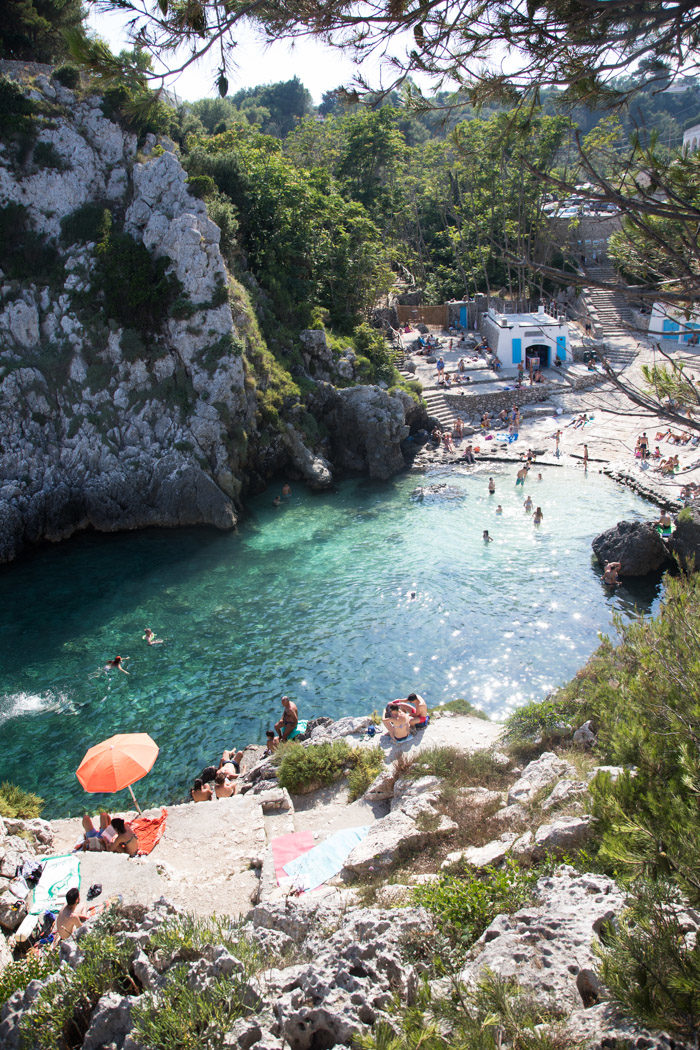
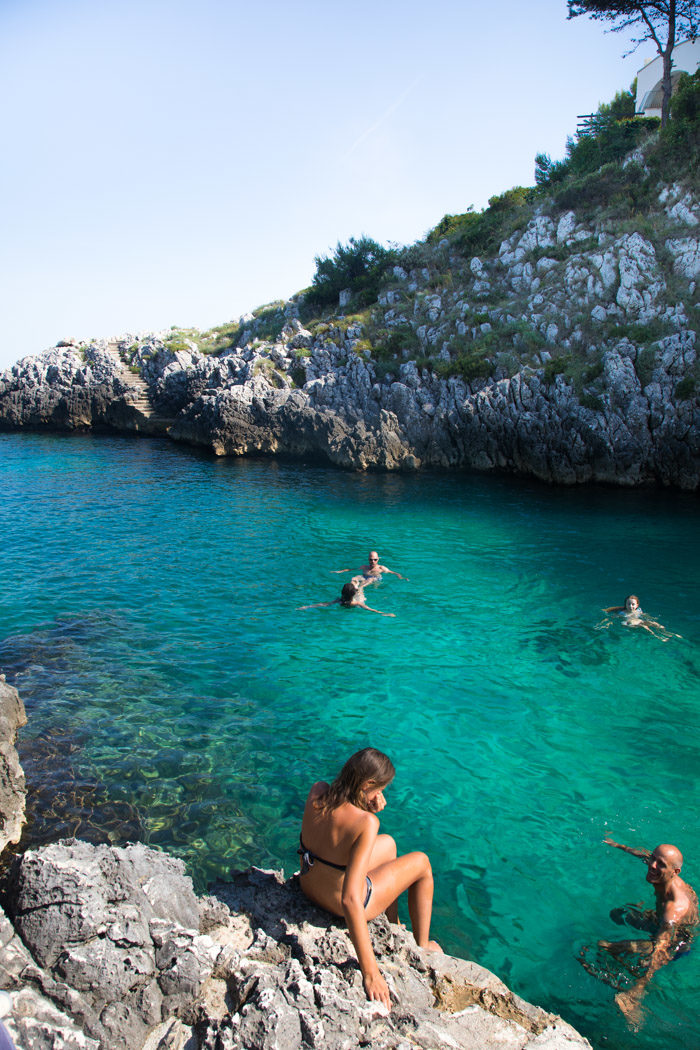
I’d stumbled on our next stop, Cala dell’Acquaviva during some Instagram searches of location tags in the area, and as soon as I saw it I knew I wanted to go there. As it happened, it was actually the closest beach to our Airbnb.
The water in this inlet is the most incredible shade of blue, but it’s also much colder than most of the sea as it’s fed by an underground spring. You could feel it bubbling up underfoot!
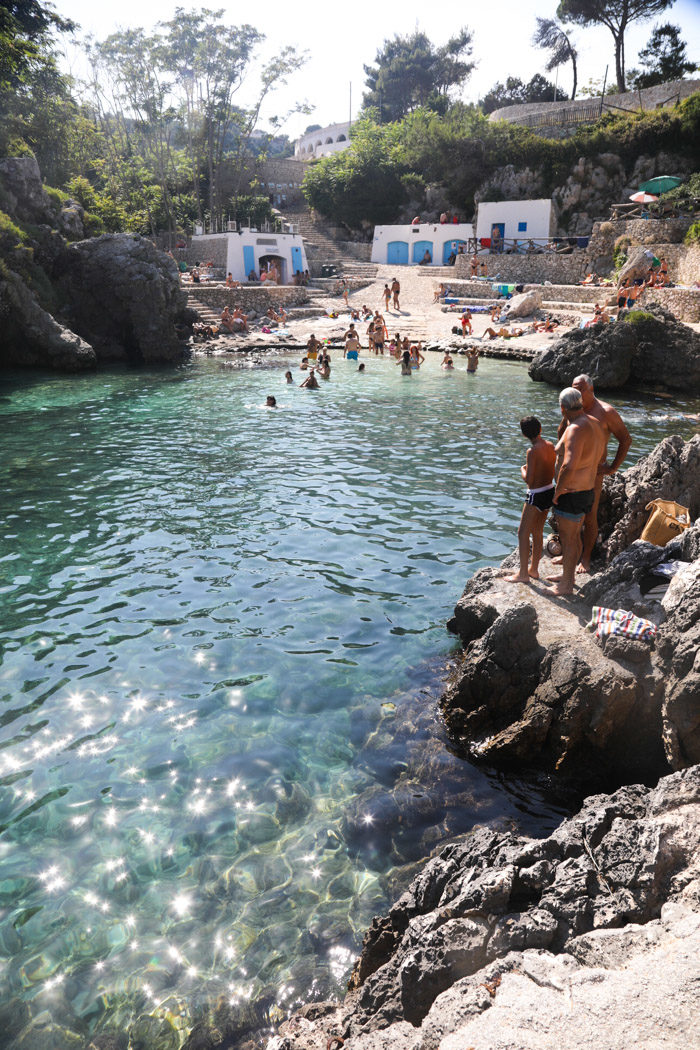
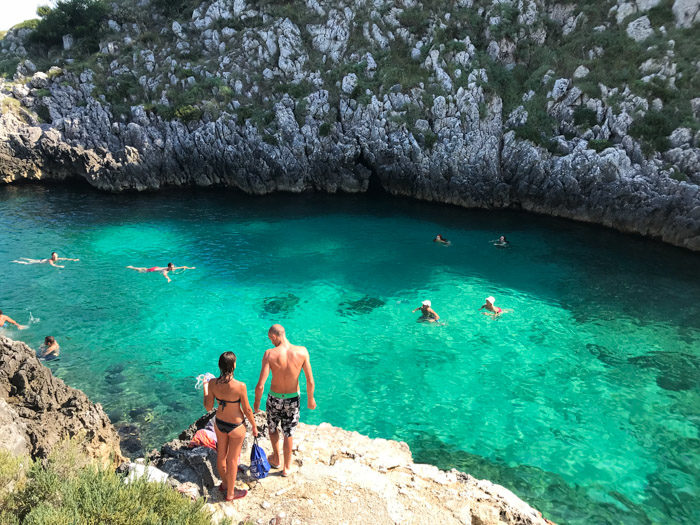
The fjord stretches along the rocks, perfect perches from where one can watch brave young souls leap into the deeper parts!

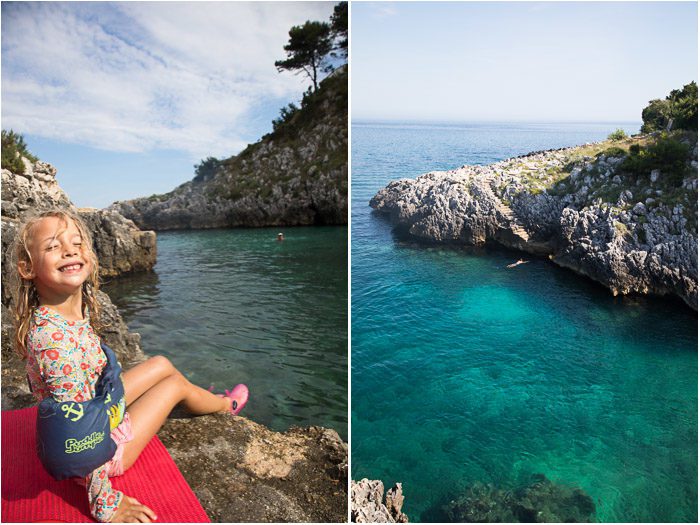
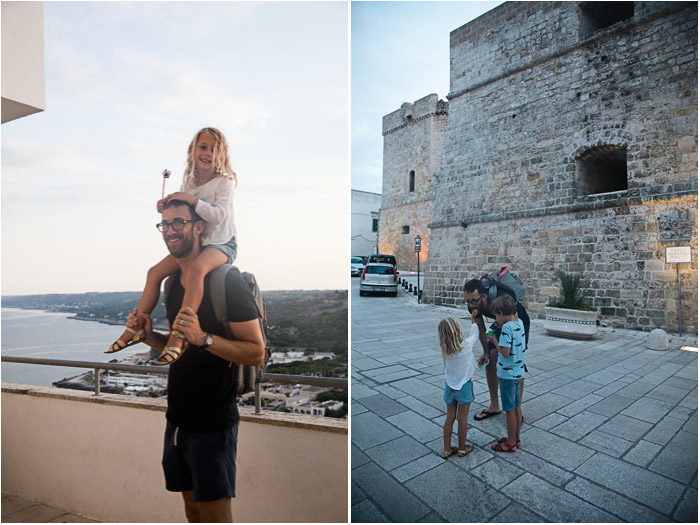
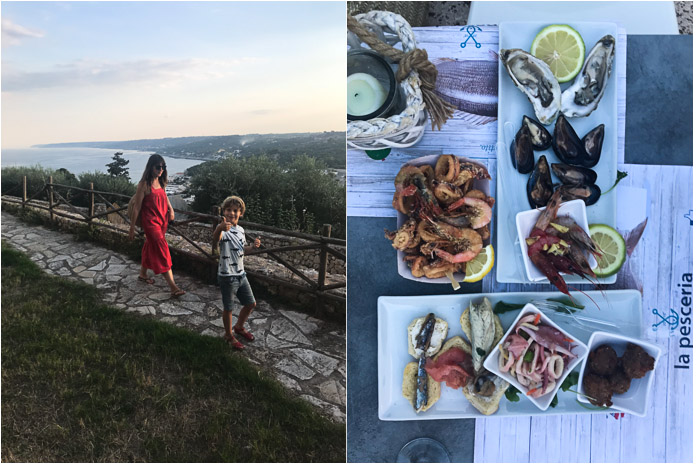
When the sun started to fade, we left the cove and the village of Marina di Marittima, and drove back to Castro, this time following the curvy road up to the citadel.
For centuries, Puglia’s east coast was prone to raids from Saracen invaders, Ottoman navies, and other marauders, sending those who lived by the sea seeking refuge inland. Small towns sprang up along the spine of the Salento peninsula, and seaside cities like Castro built their centers back from the coast—so the Castro marina and the old center feel like two different places.
We walked the fortifications, taking in the sweeping sea views, and then stopped in the village for some apertivi (and some piazza playtime) before heading home for dinner. We chose seafood at la Pesceria, but there was also a wine bar where one could taste some of the local wines—like negroamaro, primitivo di Manduria, or Salice Salentino. On a longer visit, one can go inside the medieval castle to admire the statue of Athena, part of a temple recently discovered. At the time of the Roman empire, the town’s name was Castrum Minervae, or Athena’s camp.
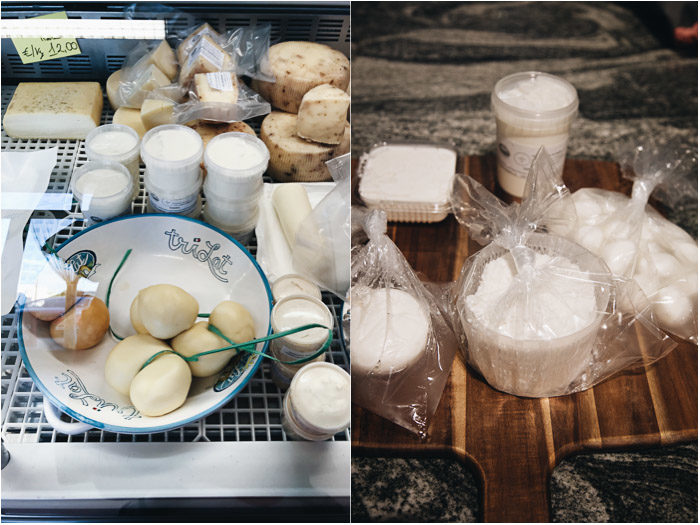
Earlier, during our driving between villages, we’d stopped at a cheese maker’s storefront (Artisan Caseificio TriLat Case di Latte in Tricase) and picked up fresh yogurt, burrata, mozzarella, stracciatella, and ricotta (all that is pictured above) for the bargain price of 12Euro. So while there were so many restaurants around that sounded amazing, we opted once again to keep it simple and make some pasta and eat some great cheese at home.
I should note, the choice to eat at the Airbnb or find a restaurant (and make it, once again, a very late night out) didn’t feel as simple at the time: in hindsight I’m sure we made the right decision, but it was often a hard choice. Were we missing out on one of the many wonderful restaurants around? Would our kids even last through another long, late meal? As I mentioned before, I found this to be one of the main challenges on the trip.
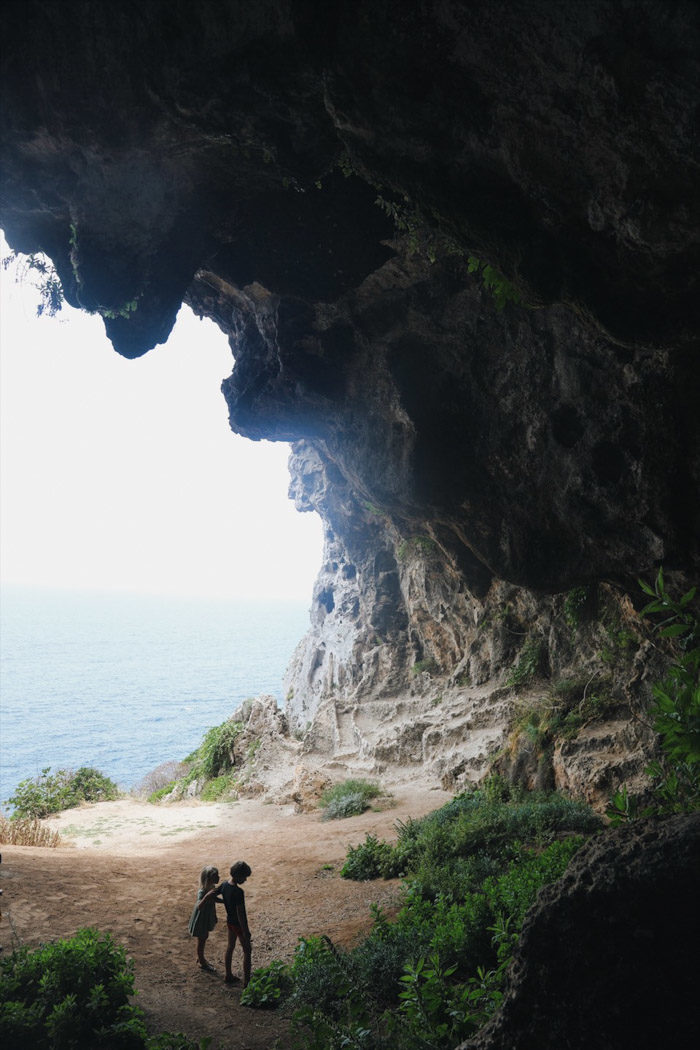
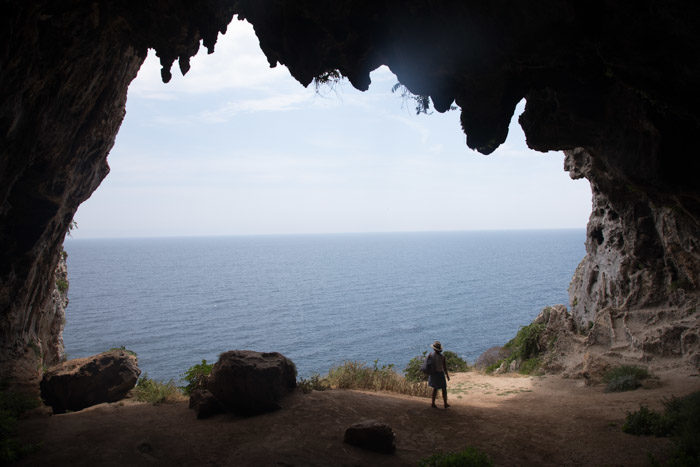
The next morning, we drove back toward the Gagliano del Capo and just happened upon a signpost marking the trailhead for Il Sentiero delle Cipolliane. The kids skipped along the path, on the cliff between Marina di Novaglie and Ciolo, toward four caves with evidence of life dating back to the Upper Paleolithic era. Their name comes from the wild onions that grow and scent the air in the caves.
Aron remarked later how lovely that short walk was—watching the kids with this amazing backdrop, butterflies and lizards coming in and out of view, and Skyler telling him how she wanted to be a princess by the time she was sixteen.


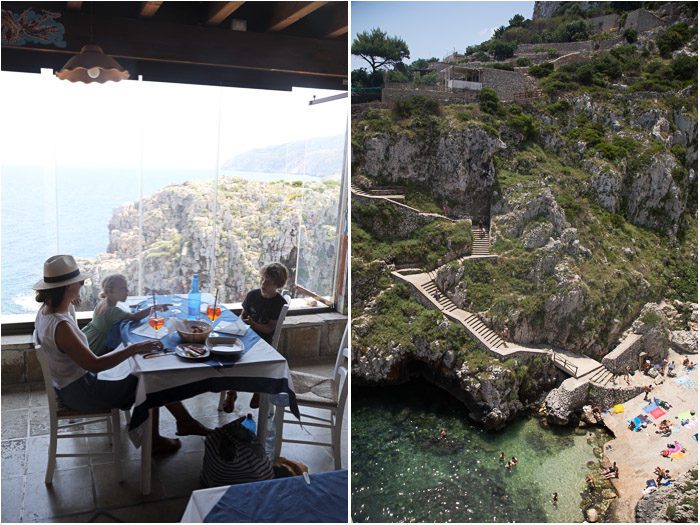
The Ciolo fjord opens onto the Adriatic and, on clear days, offers a view that stretches to the coasts of Greece and Albania. But it’s easy to forget to look out, when so much of the view is down.
We parked along the road at the top of the coastal bridge overlooking the cove—astonished to think of divers making the 100-foot jump—and stopped at the cliffside restaurant, L’Incanto, for lunch before heading down for a swim. Aron and I shared mussels and a caprese salad, and the kids were thrilled to share a whole grilled fish.
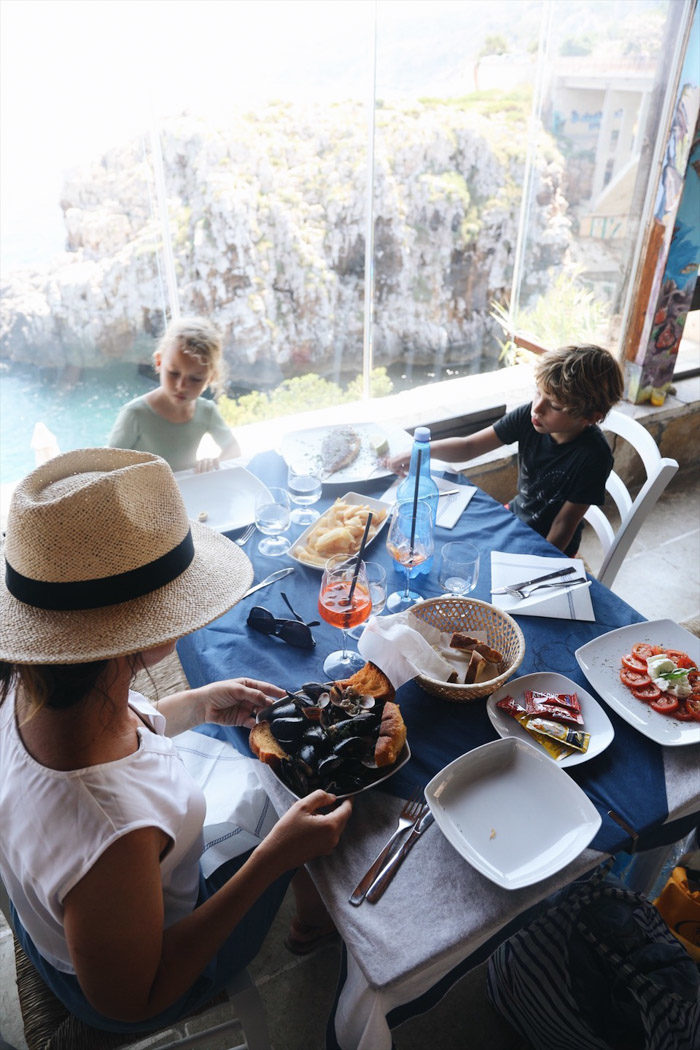
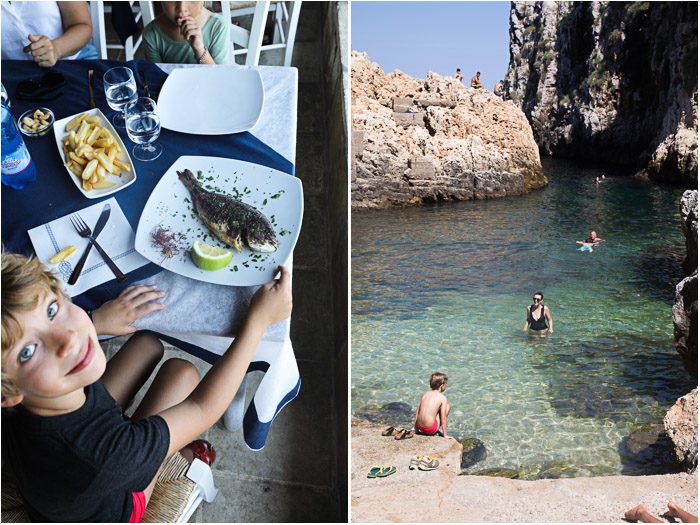


On the bottom there is a tiny beach—actually a stretch of cement poured for local fisherman to use as a slipway, and a bit of sand—where one can wade out before the water quickly gets very deep.
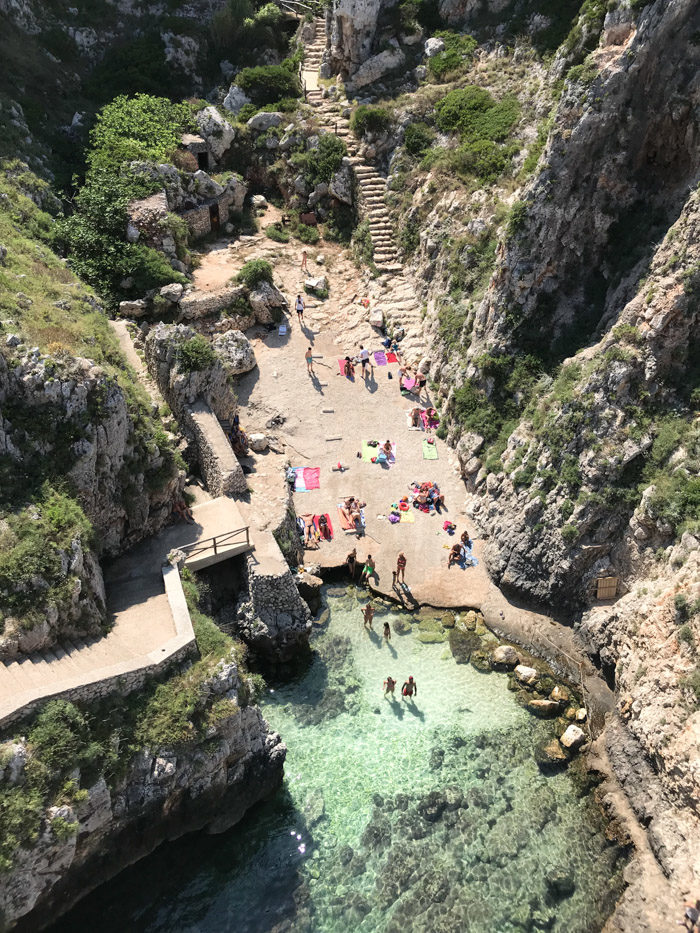
Local kids scampered up the rocks on all sides, to dizzying heights, and would plunge into the water. One had to be careful to look up while swimming out to sea, taking care not to go directly beneath those making jumps—and even then the sound of the impact, like bombs hitting the water, could make you a bit anxious!
We felt both pride and trepidation seeing Hudson so fearlessly swim around, looking for sea caves and jumping from the lower perches. Skyler and I watched from the shore as Hudson and Aron made some jumps, and she was so happy to cheer them on.

From Il Ciolo, we kept driving south, following a jaw-dropping coastline of rocky cliffs, until we reached the tip of the boot’s heel, where the Adriatic and the Ionian seas meet, at Santa Maria di Leuca.
A popular resort for wealthy Puglians since the early 1900s, with Art Nouveau villas that line the seafront, Leuca is a holiday town with many sandy beaches (Felloniche, Posto Vecchio, Torre Vado, and Pescoluse—also called the Maldives of the Salento) and karstic grottoes; the Santa Maria in its name refers to a sanctuary, also known as the Basilica De Finibus Terrae, that has long been a place of pilgrimage and is particularly busy around the middle of August each year.
When we visited, the winds were quite strong, so we stayed just long enough to look out to the lighthouse before turning back north. (We’ll always remember this drive for playing “In the Car” on repeat and singing along.)
That reminds me of something the pictures don’t show: every day the forecast would say that we were going to get some rain, and every night Aron and I would look at the weather and try to figure out the best route and the best destinations while taking the wind and possible rain into account. It was windy, but the rain never came. In retrospect, it seems so silly how much time we wasted worrying about it!
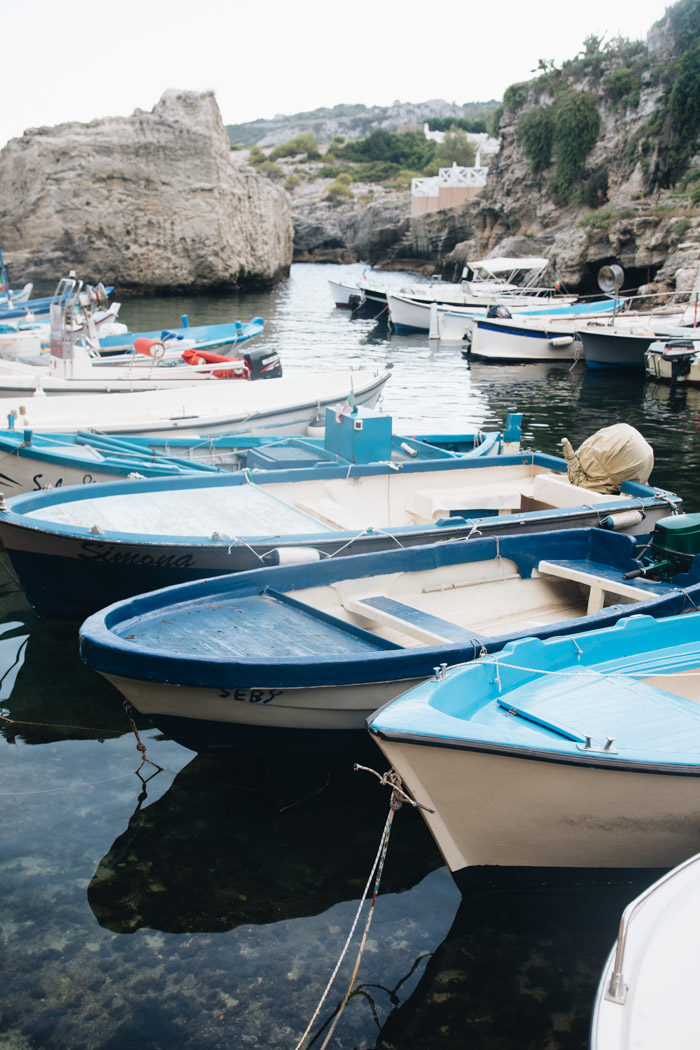
During our short hike on the path to the Cipolliane caves, we’d noticed the charming harbor of Marina di Novaglie nearby. As it turns out, it’s known for its restaurant Lo Scalo, with caught-this-morning seafood, chilled local wines, and a stone staircase leading straight down into the water. Daybeds can be rented as well, although it looked like the kind of place that would be best suited to couples.
We were early for dinner, so we just used the staircase for one more brief swim before returning home for the night.
There were a number of restaurants in the area that our hosts recommended to seek out, but which we didn’t get a chance to visit: Il Foletto, Lemi, Trattoria Vardaceli, Le Stanzie, La Locanda dei Camini, Farmica di Sani, Gli Ulivi, and La Piazza; and in Otranto, L’Altro Baffo and Da Sergio Otranto.
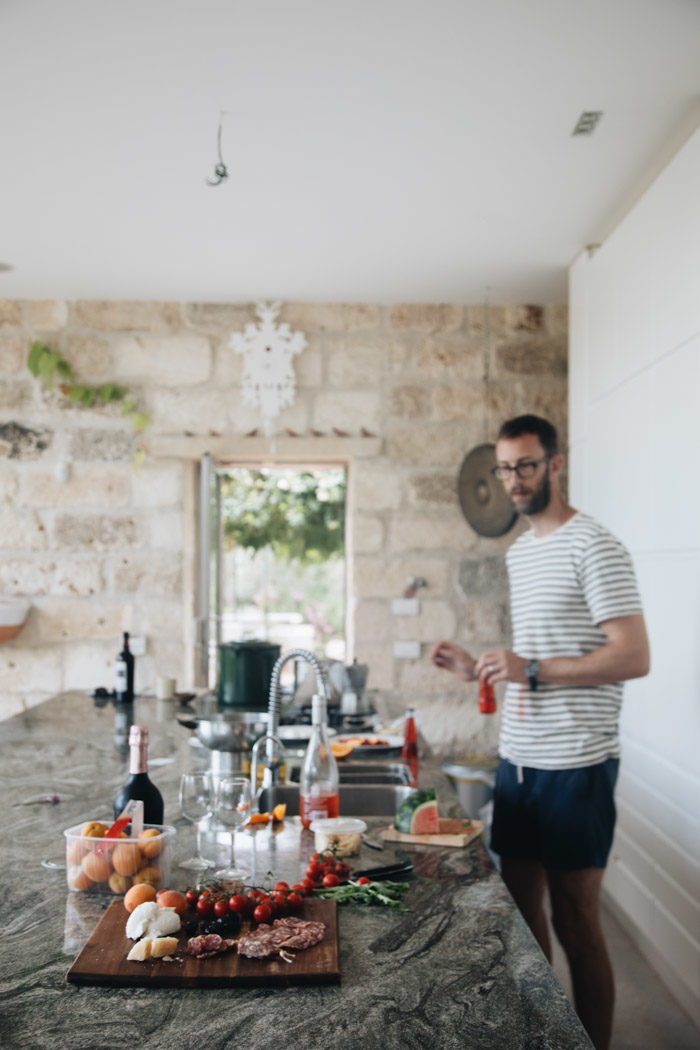
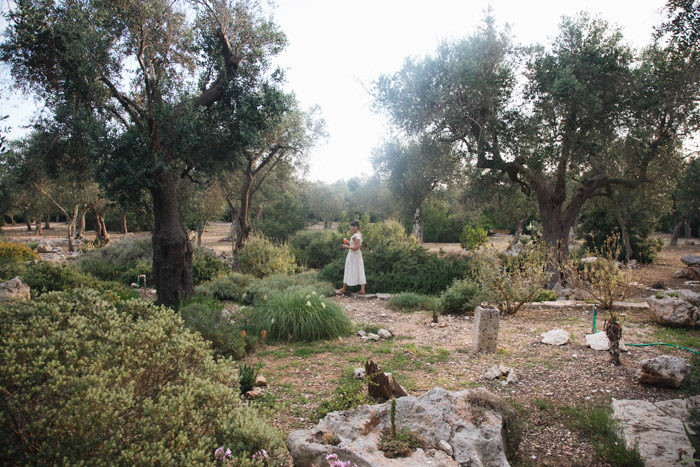
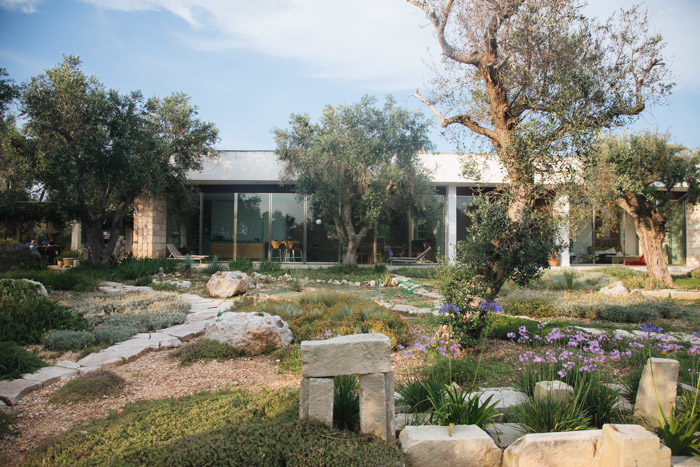
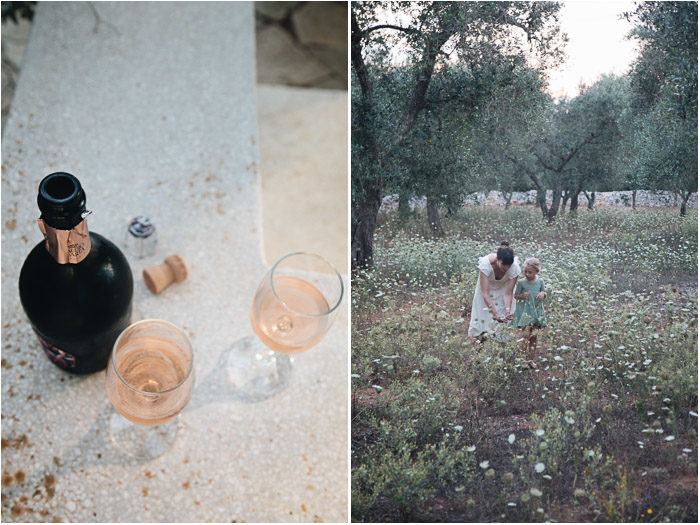
It was the summer solstice, the day when the sun reaches its highest position in the sky and stays out the longest, so we went on a mid-meal, sunset walk in the olive groves around the house.

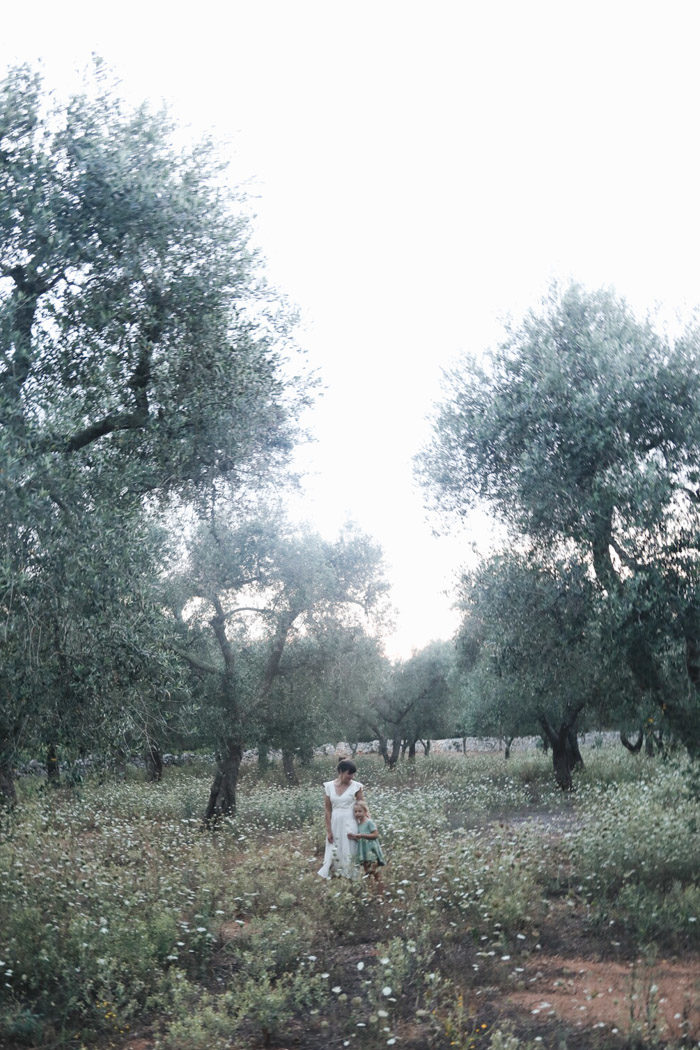
I felt like I was living out all of my Stealing Beauty-inspired Italian dreams!

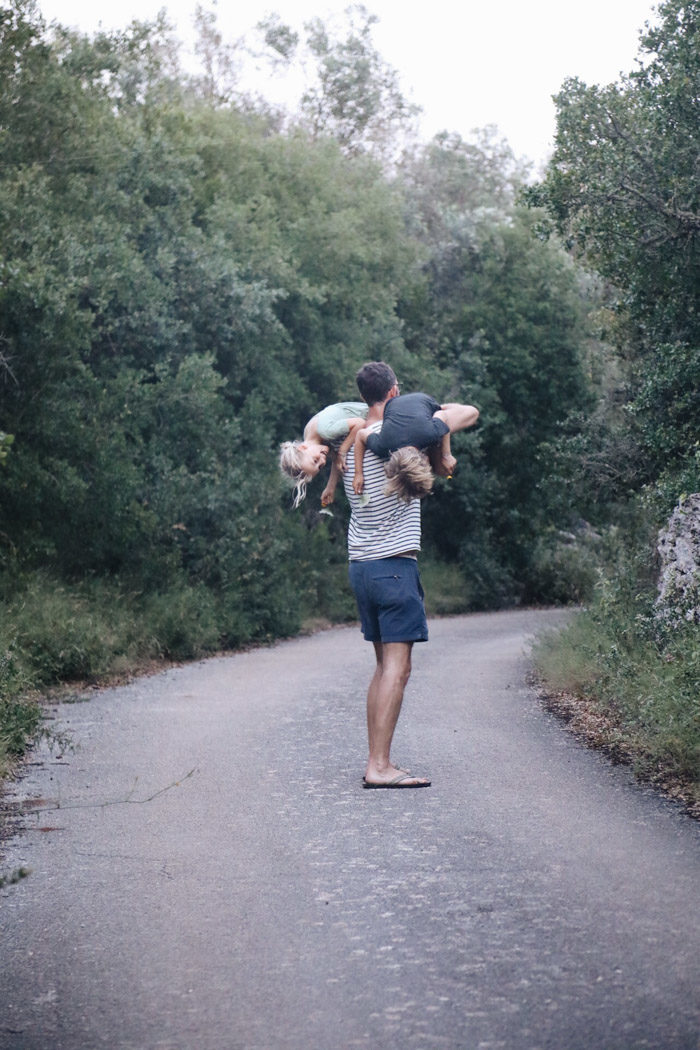
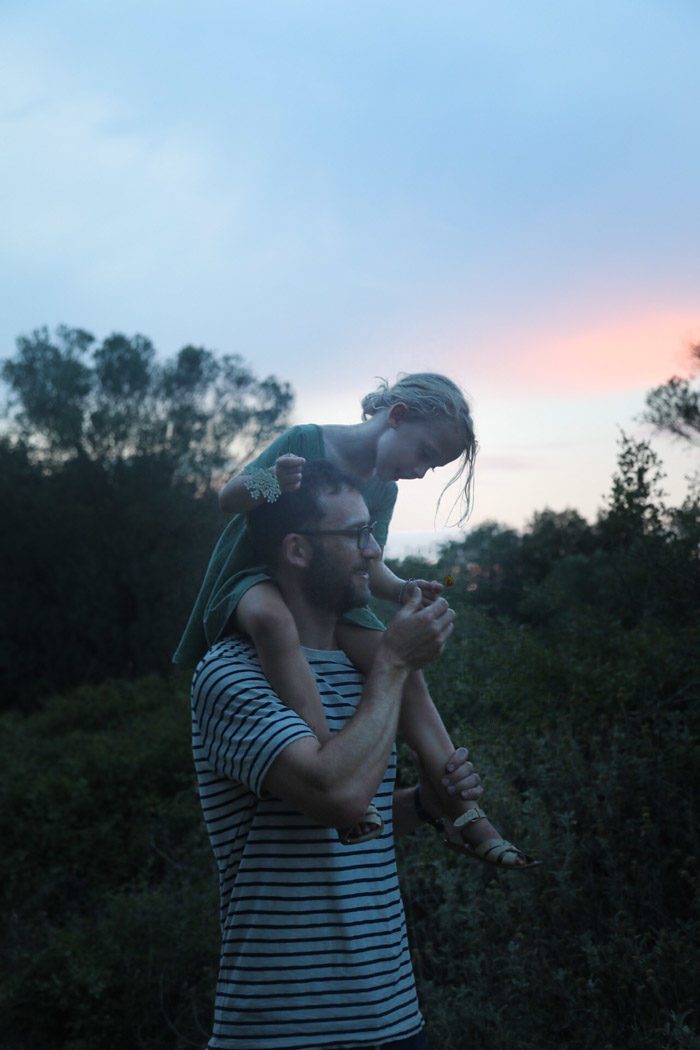
How lucky we were to have those extra moments of daylight to appreciate this place on our last night.
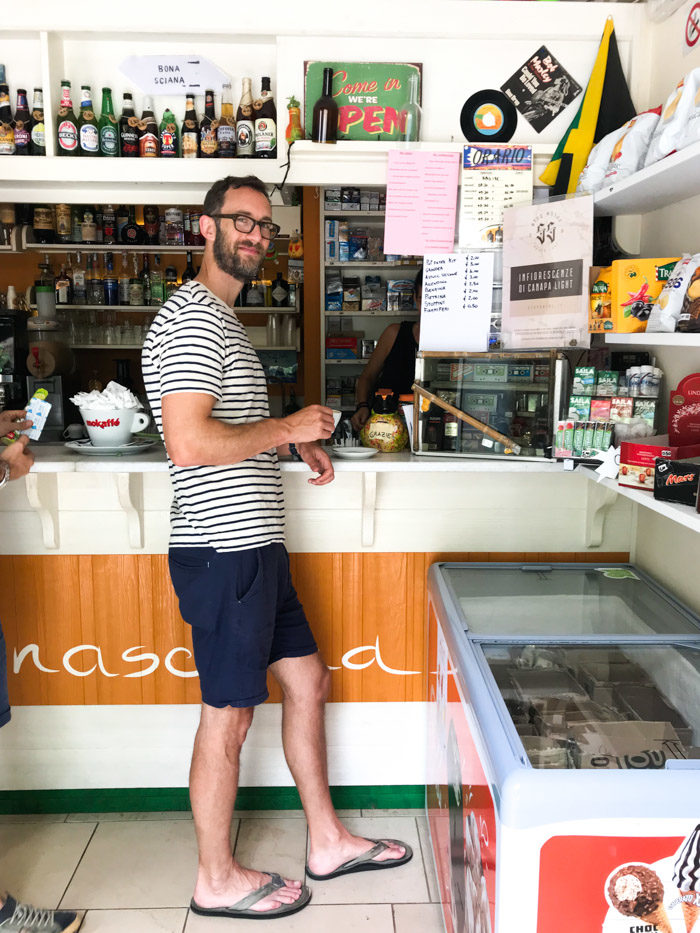
We weren’t moving far, however: when we packed up our things we only moved about 30 minutes away—to a hotel on the coast in Santa Cesarea Terme. There wasn’t much written in American guidebooks about the Salento, and so we just had to make educated guesses about the best home bases. We guessed correctly that this would be a beautiful area to explore.
To be continued…
Have you been? Anything to add?
Next up: More Salento (with Polignano a Mare)
Previously: Rome; Matera and Herculaneum; Valle d’Itria & Lecce
Also from Italy: Sardinia, Tuscany, Positano and the Amalfi Coast, Rome, where to shop in Venice, and our first trip together to Italy, with stops in Venice, Cinque Terre, and Florence. Also, some thoughts on travel (in Italy and beyond) with kids.


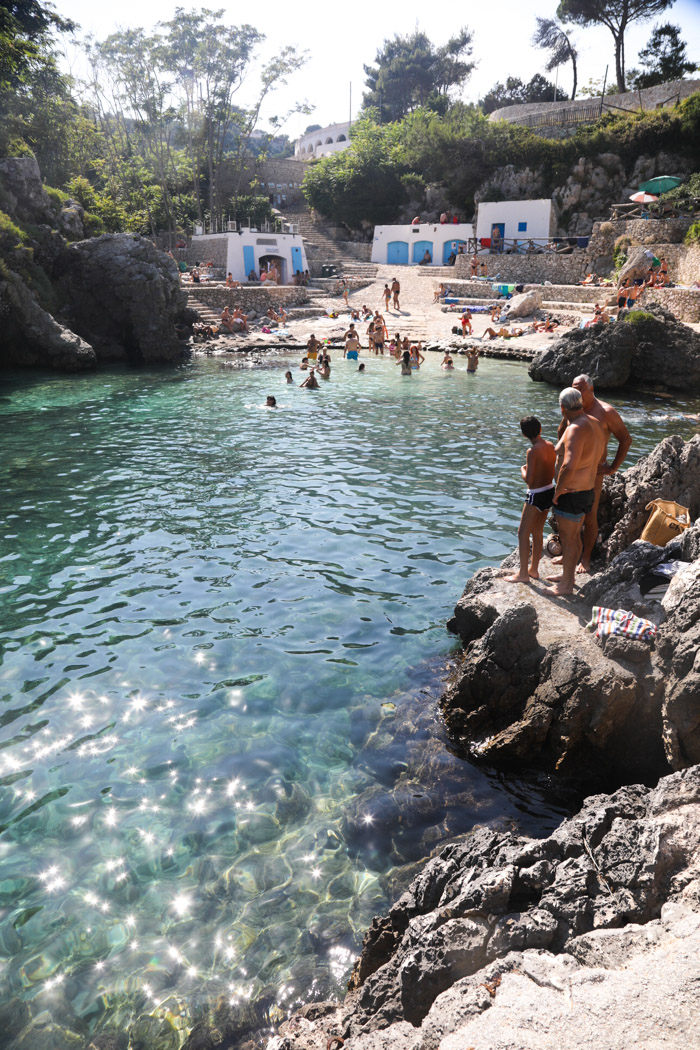
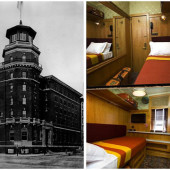
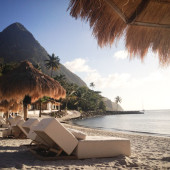
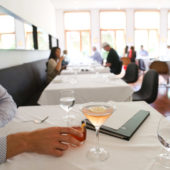
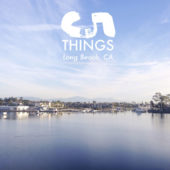









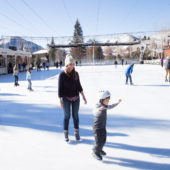

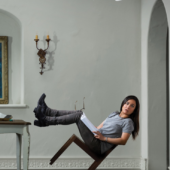
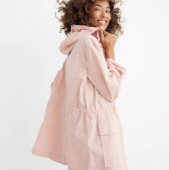


















16 Comments